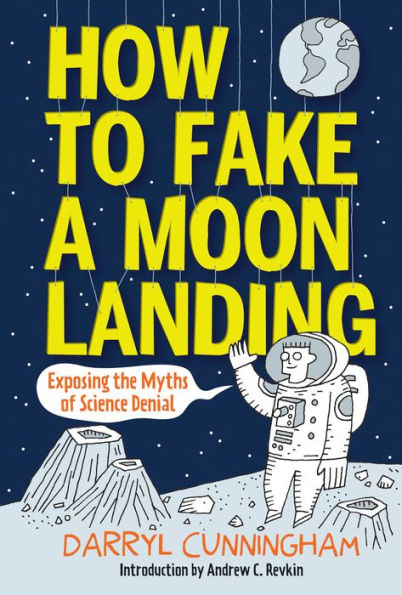Read an Excerpt
INTRODUCTION
I was happy to discover Darryl Cunningham's book because he takes a long tradition of demystification and truth seeking to a new generation in a new way. The tradition goes back centuries. Galileo and Darwin fought mightily to use observation, logic, and mathematics to create a reality-based view of the universe and humanity's place in it. It's never been easy. For Galileo, who used observations of the planets and stars to show that the Earth was not the center of the universe, the result was house arrest for the final years of his life as religious leaders fought the erosion of worldviews based on faith. Darwin meticulously and patiently spent more than twenty years assembling his argument and evidence for evolution before the publication of The Origin of Species, yet a large portion of society still rejects that firmly established theory.
In recent decades, scientists have been aided by generations of science writers and journalists in their quest to explain and defend their insights about the forces shaping the world. Also helping out are professional debunkers like James Randi. In the early 1970s, at age sixty, Randi moved from a career as a magician (his stage name was the Amazing Randi) to a life focused on separating myth and illusion from reality as a co-founder of the Committee for Scientific Investigation of Claims of the Paranormal. Randi has since been joined by television's popular MythBusters team and defenders of the scientific method ranging from Bill Nye the Science Guy to a growing network of science blogs. Just one example is RealClimate.org, a vital touchstone on climate-change research maintained by a team of accomplished climatologists. NASA has gotten into the act using the tools of social media to tamp down occasional waves of hype surrounding a serious challenge — efforts to find and track asteroids that might someday collide with Earth. The space agency's @AsteroidWatch Twitter account is followed by nearly one million people, and provides a beacon of credibility in the great online mash-up of rumors and facts.
Cunningham's innovation is to create a refreshing mix of clear explanatory writing, touches of humor, and engaging and accessible artwork. Like other debunkers, of course, he is more of a truth seeker than a truth teller, given that scientific knowledge is, by nature, a moving target. It was "true" until this century that stomach ulcers were caused by stress or bad diets. After many years of resistance from mainstream medical scientists, it has become clear that a bacterium, Helicobacter pylori, is the culprit. (The discoverers had to wait more than twenty years to get their Nobel Prize in 2005.) More recently, biologists studying the human "microbiome" — the human body as an ecosystem — have found that while these bacteria harm the stomach, they provide some benefit to the esophagus, and their decline in Western societies may be related to a rise in asthma, as well. The journey continues.
By fostering the capacity for critical thinking rather than simply providing examples, How to Fake a Moon Landing is invaluable given that science and technology will always be providing new material for myth makers to latch on to. The existing debate over nuclear power and genetically modified foods will soon give way to battles over synthetic biology and nanotechnology.
With this book, Cunningham reveals the roots of misinformation and intentional disinformation. There's plenty of both out there. But, more important, he provides a road map for how anyone can do this. One of the great challenges — and opportunities — in twenty-first-century life lies in finding ways to navigate the sea of assertions and facts we face on the Internet and come away with some sense of what's really known and unknown, or simply feared or imagined, in a complicated, dynamic world. When I was coming of age in the mid-twentieth century, there was usually some authority doing the work for you, whether a silver-haired anchorman on the nightly news or the printed front page of a newspaper. Now, no matter what your predispositions, you can probe the web and, seconds later, come away with information or ideas that bolster them.
Maintaining a capacity for critical thinking, including the capacity to appraise one's own beliefs, has never been more important. In some parts of this book, to my eye, Cunningham's deep passion for defrocking falsehoods has carried him too far. I feel he's too hard on chiropractors, for instance, because he doesn't include as rigorous a look at the overselling of many conventional medical treatments for back pain, including surgery, that have not been demonstrated to be more effective than rest and pain medication. I think his portrayal of environmental risks from the gas- drilling method known as "fracking" doesn't adequately account for studies showing that problems, while real, are very rare. But don't take my word for it. Dig in. Find out how to use Google Scholar to probe basic research. Read a scientific paper. Talk to a scientist! They're not hard to find, and most are eager to help the public understand their work.
I'm sure Cunningham would be happy to have readers finish his book and raise their own questions about his conclusions. That would mean they've absorbed his prime message. As he explains in the preface, "This book is pro-science and pro- critical thinking. It isn't a book promoting a scientific élite whom we must all follow, sheep-like."
In the end, I'm sure he's hoping that after you've read this book, you'll be dead set on becoming your own best myth buster. Personally, I can't think of a better outcome.
(Continues…)
Excerpted from "How to Fake a Moon Landing"
by .
Copyright © 2019 Darryl Cunningham.
Excerpted by permission of Abrams Books.
All rights reserved. No part of this excerpt may be reproduced or reprinted without permission in writing from the publisher.
Excerpts are provided by Dial-A-Book Inc. solely for the personal use of visitors to this web site.



